Grippingly and emotionally stressing over how to best contend with legal and moral dilemmas that not only affect your life, but countless people directly and indirectly connected to your life is a riveting driving force in scribe-helmer Paul Thomas Anderson’s new film, the crime comedy-drama, Inherent Vice. Not only is the movie’s main character, private investigator Larry “Doc” Sportello, determined to uncover the truth behind several recent disappearances, but the actors also thrived on connecting with, and supporting, each other while filming. Anderson, along with several performers from the film’s ensemble cast, including Owen Wilson, Martin Short, Benicio Del Toro, Maya Rudolph, Jena Malone, Michael K. Williams, Sasha Pieterse, Joanna Newsom, Katherine Waterston and Hong Chau, discussed the process of capturing that support during a press conference at Lincoln Square’s Walter Reader Theater, before the comedy-drama’s world premiere at the 52nd New York Film Festival.
Set in Los Angeles in 1970, Inherent Vice, which was adapted from the 2009 book of the same name by Thomas Pynchon, follows Doc (Joaquin Phoenix), as he’s visited by his former girlfriend, Shasta Fay Hepworth (Waterston). Shasta is concerned about the man she’s having an affair with, real-estate mogul Mickey Wolfmann (Eric Roberts). So she asks Doc to help stop Mickey’s wife, Sloane (Serena Scott Thomas), and her lover to have Mickey admitted to a mental health institution. Doc is then approached by Tariq Khalil (Williams), who asks him to find another person associated with the Wolfmanns, Glen Charlock (Christopher Allen Nelson), who serves as one of Mickey’s bodyguards. Tariq claims that Glen owes him money after they served together in prison.
After Doc visits one of Mickey’s developments, he inadvertently becomes a suspect in Glen’s killing. One of the investigator’s nemeses, Detective Christian “Bigfoot” Bjornsen (Josh Brolin), tells Doc that Glen Charlock has been shot, and Mickey has vanished. Doc is later visited by Hope Harlingen (Malone), the wife of saxophone player Coy Harlingen (Wilson), who wants Doc to look into rumors that Coy is still alive, despite the reports that he has died.
Doc ultimately tracks Coy to a nightclub, and when the two finally meet, the musician tells the investigator about the vessel, the Golden Fang. The boat is suspected of bringing mysterious goods into port, and Mickey and Shasta are believed to have been taken on board. Doc also discovers that Coy has been working for the government as an informer, but isn’t allowed to contact his family. So not only does Doc set out to locate his ex-girlfriend and her new lover, but also uncover the truth behind Glen’s murder, the Golden Fang and how to safely return Coy back to his family.
During the Inherent Vice press conference, Anderson and the actors discussed their experience of working together on the set, including how the filmmaker allowed the actors to fully explore the creative process, until they found the elements that worked best for each scene. The director also revealed that shooting on 35mm was something he started doing in the beginning of his career, and he continues to do so because he’s trying to keep film alive a little bit longer.
Question (Q): Paul, what was the process of returning to making an ensemble piece, instead of just focusing on one or two characters in your film?
Paul Thomas Anderson (PTA): It felt great, for all the obvious reasons. I got to work with all these great people. The only frustrating thing was that it was only for two or three days for most of the cast. Just when we really got started getting excited, they’d leave and go off to other movies. I was stuck with (Phoenix) most of the time. (laughs) But it was a great feeling.
Q: For the actors, what was the experience of working with Paul? How did you all like to work on the set?
Sasha Pieterse (SP): What I loved about working with Paul was that he let us go at our scenes. There was one take in particular where all three of us (Phoenix, Short and herself) did something completely different. We didn’t tell each other, and we just put our characters into that place. We collaborated and it turned to something beautiful. That’s what made the film come together: this chaos that we all brought that turned into something simple.
Martin Short (MS): If you’re working with a great director, you feel very, very, very safe, because you know that all the decisions will be made months later in the editing room. I loved how many variations there were of our scene. I would improvise a line, and would ask Paul, “Should I do that?” He’d say, “Yes, do it again!”
Owen Wilson (OW): It was a very loose way of working. Sometimes I wouldn’t necessarily know what I was doing. Like Martin said, we were encouraged to do anything, and in the decisions that we made. I don’t remember much improvising, but it was loose and chaotic.
Jena Malone (JM): With Hope, we just started with the words, because they were so important. That was a new thing for me-really focusing on the words. We focused on the narrative of the story before doing anything else. We had so many little things to pull from such a giant source. It was nice to sit down with (with Paul) and see what felt right. That was a very structured process.
Michael K. Williams (MKW): It actually makes me feel good to hear you say that-I thought it was just me. (laughs) I didn’t know if Paul liked me! It was very loose on the set.
I came into the project as a big fan of both Joaquin and Paul. I hadn’t slept for 48 hours before I shot my scene, as I went straight there from another job. The process on the film was different for me, as most of my credits are on television, where everything’s driven by time.
Then with this situation, Paul said he wanted to sit down and talk about it. I was like, “Really?!? (laughs) You don’t want me to just perform?” He said, “No, let’s talk about it.”
Joaquin was also so generous. I came in very intimidated to perform with such an incredible talent. To be put into this situation, though, I thought Paul didn’t like me! (laughs) Although the process was new for me, I did know I was safe. I’m grateful to have been given this opportunity.
Hong Chau (HC): I don’t think Paul went into it knowing exactly what he wanted. I think he liked to experiment and have the possibility of interesting things happening on the day of, and I think that’s what he wanted to capture.
Maya Rudolph (MR): What I love so much about Paul’s work is that it’s anything and everything, and it’s always his. It allows for a scene to be crazy, but then something else to be dark and mysterious. Plus, I got to improvise a little bit about an Afro!
Benicio Del Toro (BDT): Paul would take a scene that takes place on a table and he’ll move it into a car. It was like dancing in a way, and I really enjoyed it. I think working with Joaquin, and also my scene with Josh Brolin, were a lot of fun; there was a lot of laughing and Paul was laughing at us.
Katherine Waterston (KW): Working with Paul was the best creative experiences I’ve ever had-I don’t know how he does what he does.
Q: Paul, one of the interesting aspects of the film was how you shot both sides of the conversations throughout the story. How did you find that rhythm of showing both actors throughout the conversations, particularly the phone calls?
PTA: With the conversations between Joaquin and Owen, for example, we had two really good actors and great dialogue. Anytime you can film conversations like theirs, without having to cut them together, works so much better. It more easily sets up their thoughts and actions. Joaquin and Owen were capable of doing it, so it really was that simple.
Q: Paul, your films’ are so different from each other, but they’re all centered on masculinity. Can you discuss that aspect of your movies, and why you decided to feature a female narrator in Inherent Vice?
PTA: Well, Joanna’s sitting right here. I’ve known her, and loved the way she talked and the way she looked. In the book, she’s presented as a supporting character, and is Doc’s best friend. She always seems to know more about things than he does. Along the way, we were looking to have a good female voice, so I asked Joanna to do it. I’m glad I asked her to do it, because it worked.
For a long time, I was told if you use voice-overs, that’s a no-no. You have to let the characters do the work for you, and not rely on narration. So I got paranoid that you shouldn’t use a narrator. While some of my favorite films use narrators, I was always paranoid to do it. But I thought there was so much great stuff Joanna’s character could say that would be helpful to the story, and not subtract from what was going on.
Joanna Newsom (JN): I felt I had a responsibility to speak for the actual text. I felt yoked by this sense that nothing should come out of my mouth that wasn’t written in the book or, at least, in the script based on a decision made by the writer.
Q: Paul, you shot ‘Inherent Vice’ on 35mm stock (which was shown during the film’s world premiere at the festival). Why did you decide to shoot the movie on film?
PTA: (Shooting on 35mm) was something I started doing back at the beginning (of my career), so it’s the only way I know how to do it. I have a nice print to show, along with all the nerves that accompany that. Like, everything could break easily (in the middle of the movie), and that adds to the thrill of it all. I’m just trying to keep (film) alive a little bit longer. There’s room in both things, and that should just be how it is. Nothing should go away.
Check out an exclusive clip and photos from the ‘Inherent Vice’ New York Film Festival press conference below.
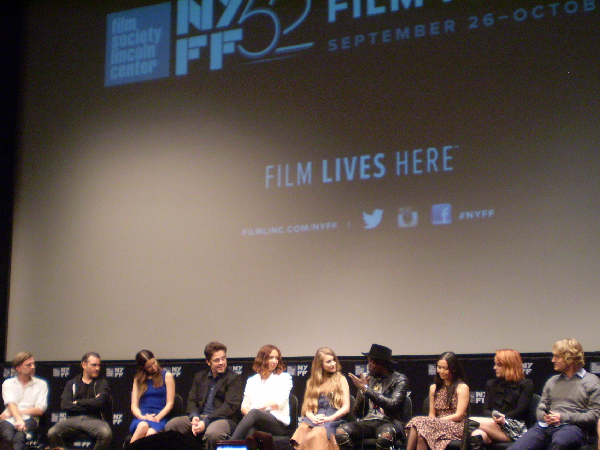
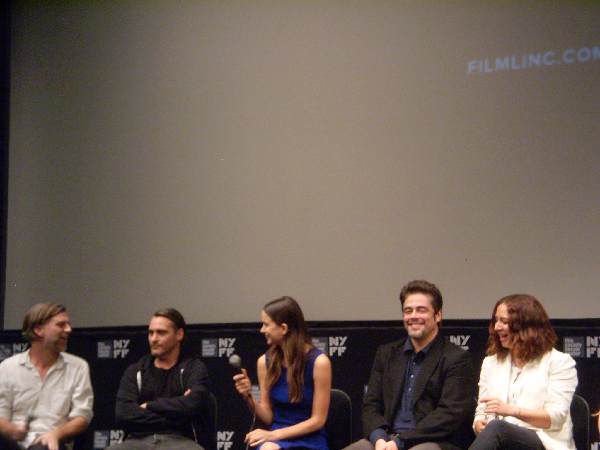
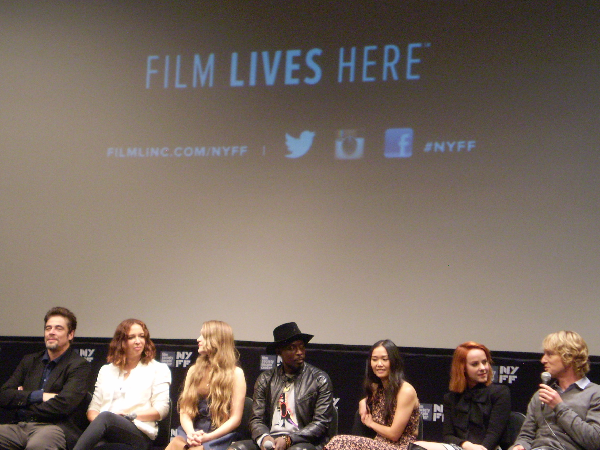
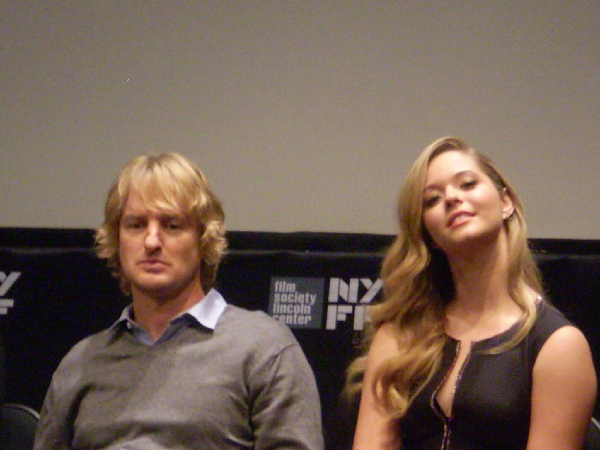
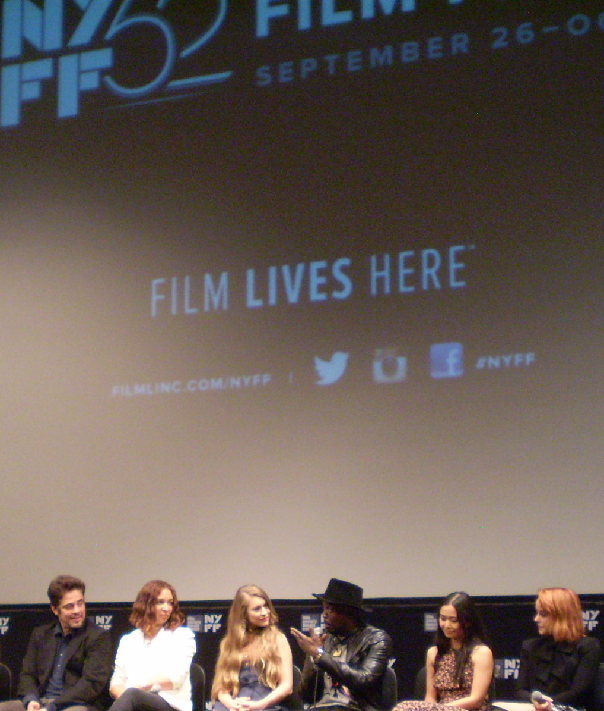
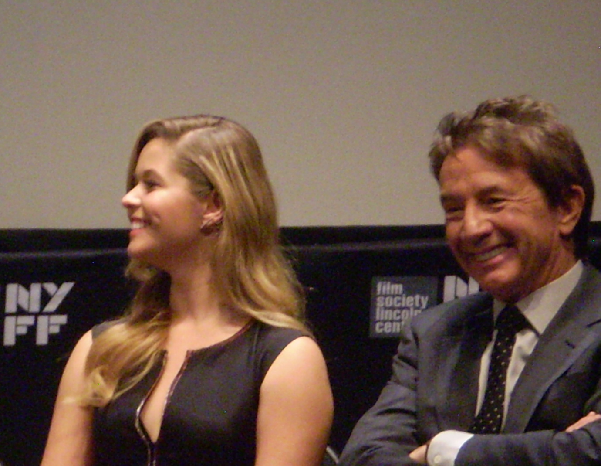
Written by: Karen Benardello
